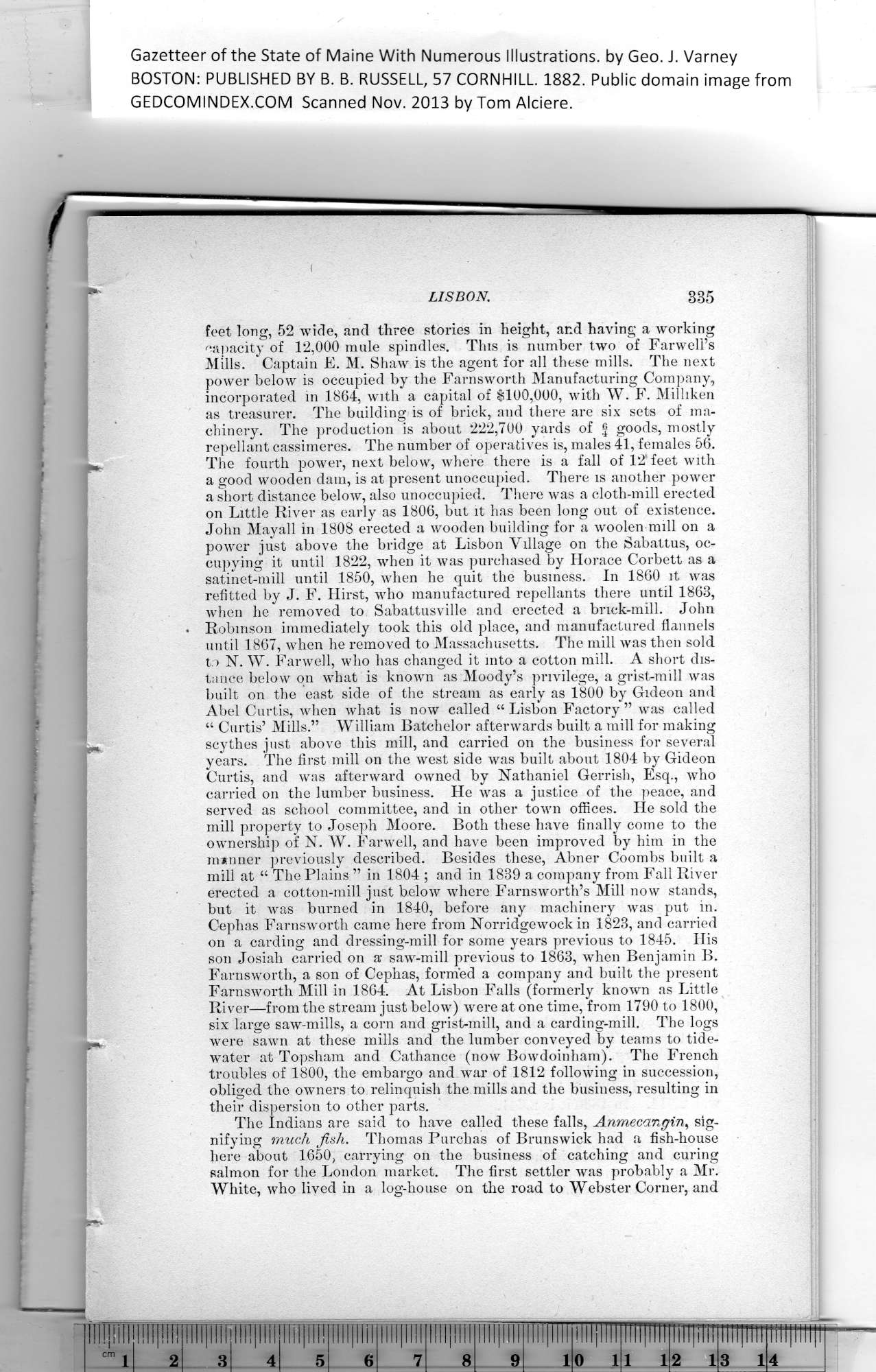|
Gazetteer of the State of Maine With Numerous Illustrations, by Geo. J. Varney
BOSTON: PUBLISHED BY B. B. RUSSELL, 57 CORNHILL. 1882. Public domain image from
feet long, 52 wide, and three stories in height, and having a working
capacity of 12,000 mule spindles. This is number two of Farweli’s
Mills. Captain E. M. Shaw is the agent for all these mills. The next
power below is occupied by the Farnsworth Manufacturing Company,
incorporated in 1864, with a capital of $100,000, with W. F. Milliken
as treasurer. The building is of brick, and there are six sets of ma-
chinery. The production is about 222,700 yards of f goods, mostly
repellant cassimeres. The number of operatives is, males 41, females 56.
The fourth power, next below, where there is a fall of 12 feet with
a good wooden dam, is at present unoccupied. There is another power
a short distance below, also unoccupied. There was a eloth-mill erected
on Little River as early as 1806, but it has been long out of existence.
John Mayall in 1808 erected a wooden building for a woolen-mill on a
power just above the bridge at Lisbon Village on the Sabattus, oc-
cupying it until 1822, when it was purchased by Horace Corbett as a
satinet-mill until 1850, when he quit the business. In 1860 it was
refitted by J. F. Hirst, who manufactured repellants there until 1863,
when he removed to Sabattusville and erected a briek-mill. John
Robinson immediately took this old place, and manufactured flannels
until 1867, when he removed to Massachusetts. The mill was then sold
to N. W. Farwell, who has changed it into a cotton mill. A short dis-
tance below on what is known as Moody’s privilege, a grist-mill was
built on the east side of the stream as early as 1800 by Gideon and
Abel Curtis, when what is now called “ Lisbon Factory ” was called
“ Curtis’ Mills.” William Batchelor afterwards built a mill for making
scythes just above this mill, and carried on the business for several
years. The first mill on the west side was built about 1804 by Gideon
Curtis, and was afterward owned by Nathaniel Gerrish, Esq., who
carried on the lumber business. He was a justice of the peace, and
served as school committee, and in other town offices. He sold the
mill property to Joseph Moore. Both these have finally come to the
ownership of N. W. Farwell, and have been improved by him in the
manner previously described. Besides these, Abner Coombs built a
mill at “ The Plains ” in 1804 ; and in 1839 a company from Fall River
erected a cotton-mill just below where Farnsworth’s Mill now stands,
but it was burned in 1840, before any machinery was put in.
Cephas Farnsworth came here from Norridgewock in 1823, and carried
on a carding and dressing-mill for some years previous to 1845. His
son Josiah carried on a saw-mill previous to 1863, when Benjamin B.
Farnsworth, a son of Cephas, formed a company and built the present
Farnsworth Mill in 1864. At Lisbon Falls (formerly known as Little
River—from the stream just below) were at one time, from 1790 to 1800,
six large saw-mills, a corn and grist-mill, and a carding-mill. The logs
were sawn at these mills and the lumber conveyed by teams to tide-
water at Topsham and Cathance (now Bowdoinham). The French
troubles of 1800, the embargo and war of 1812 following in succession,
obliged the owners to relinquish the mills and the business, resulting in
their dispersion to other parts.
The Indians are said to have called these falls, Anmecar.gin, sig-
nifying much fish. Thomas Purchas of Brunswick had a fish-house
here about 1650, carrying on the business of catching and curing
salmon for the London market. The first settler was probably a Mr.
White, who lived in a log-house on the road to Webster Corner, and
PREVIOUS PAGE ... NEXT PAGE
This page was written in HTML using a program written in Python 3.2
|
